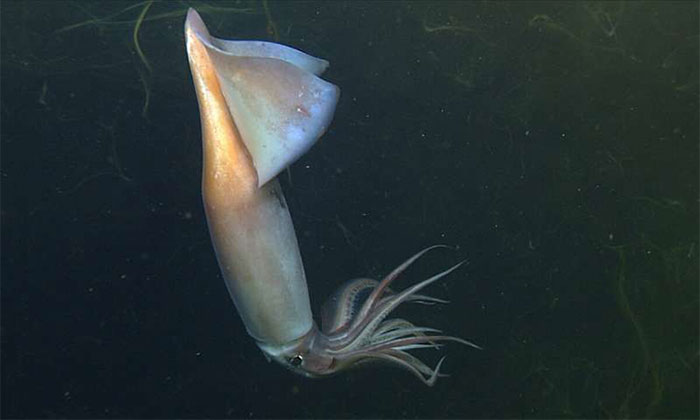The ability to help ink communicate in dark waters
Biologists published evidence that Humboldt squid can communicate visually in the dark sea thanks to its ability to glow.
In the cold waters deeper than 450 m below the surface of the Pacific Ocean, hundreds of Humboldt squid - adult-sized squid - move in groups with the distance between the members always maintained, never collision or scramble for each other's prey. How do they establish such an order in the dark sea, where most sunlight is inaccessible?

Humboldt squid.(Photo: Phys).
The answer to the study, published March 23, the Proceedings of the National Academy of Sciences, may lie in the animals' ability to communicate visually . Experts from Stanford University and the Monterey Bay Aquarium Research Institute (MBARI), USA, believe that the Humboldt squid can use special organs in the muscles to produce light, which changes the pigmentation on the skin. Members of the herd will use this pattern of change to signal to each other.
"Many squid live in shallow water without light production agencies, which suggests this could be an evolutionary trait," said lead author Benjamin Burford from Stanford University . "To survive in the deep, dark sea, they need the ability to glow to increase the contrast of the skin, facilitate visual communication."
The communication behavior of the Humboldt squid is nearly impossible to study in captivity, so biologists had to use a remote-controlled dive device (ROV) to search and record nearby animals. in the deep waters off California.
Humboldt squid hunts off California. (Video: MBARI) .
However, due to the intensity of the ROV's light, the camera could not directly observe the low light that Humboldt ink emitted. Instead, the team found evidence supporting their light communication behavior through anatomical analyzes on some of the captured squids.
In the next phase of the study, biologists want to improve ROV technology so that they can directly record the luminous behavior of Humboldt inks. In addition, they plan to create "virtual ink" with light and project it in front of real ink to see how they respond to different types of movement.
- Herd hunts and eats cannibalism at a depth of nearly 800 meters
- An interesting feature of a squid beak
- Modern technology threatens the ability to communicate
- The horse's ability to communicate by ear and eyes
- Video: How do animals see in the dark?
- 5 psychological tips that help you be respected by many people
- Gecko change color to communicate, not to disguise
- How does a smartphone ruin a child?
- The 'masters' communicate in the animal world
- Why can elephantfish look in a dark place?
- Communicate with the negative realm through social networks and messages?
- Dogs communicate with each other with their eyes
- Will the eyes see through the night?
- New explanation of the origin of dark matter
 Surprised: Fish that live in the dark ocean still see colors
Surprised: Fish that live in the dark ocean still see colors Japan suddenly caught the creature that caused the earthquake in the legend
Japan suddenly caught the creature that caused the earthquake in the legend A series of gray whale carcasses washed ashore on California's coast
A series of gray whale carcasses washed ashore on California's coast Compare the size of shark species in the world
Compare the size of shark species in the world